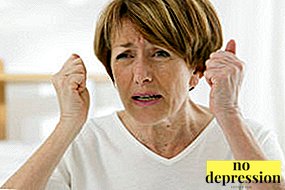In a broad sense, schizophrenia is endogenous mental disorderwhich is accompanied by a progressive disintegration of thinking and a violation of emotional reactions.
The causes of this disease can occur at any age. Symptoms and signs of schizophrenia in women have some differences from the manifestation of the disease in men.
If you suspect a mental disorder, you should be examined as soon as possible and begin treatment. Schizophrenia dangerous and incurable disease.
What is this disease?

Schizophrenia is a serious illnessaffecting the human psyche.
The disease can occur with the same degree of probability in both sexes, but the symptoms of its manifestation in women and men are different.
The disease provokes a wide range of personality disorders and defects. Schizophrenia is a chronic pathology and may develop in a latent form.
Features of schizophrenia in women:
- The first symptoms in most cases occur when they reach the age of twenty-five (for men, symptoms most often occur around the age of eighteen);
- women are characterized by a latent form of schizophrenia and a lower intensity of symptoms compared with men;
- female schizophrenia is more amenable to correction (women are more likely to restore social adaptation).
Causes
Among the causes of schizophrenia is not excluded genetic predisposition. The disease can be transmitted not only from parents, but also other relatives.
The maximum risk of disease occurs in the presence of mental disorders in both parents. Provoke aggravation Schizophrenia may be caused by numerous factors associated with a negative impact on the psycho-emotional state of a woman at different periods of her life.

Provoke schizophrenia in women, the following factors may:
- the effects of regular stressful situations and psychotraumatic factors;
- brain injury of a traumatic or organic nature;
- tendency to depression (including postpartum depression);
- traumatic situations that occurred in childhood;
- effects of viral or infectious diseases (especially with brain damage);
- negative effects of hormonal changes in the body (during adolescence or during pregnancy);
- long and uncontrolled use of psychotropic drugs;
- neurotic warehouse of personality and the presence of complexes;
- associated mental disorders (including phobias);
- consequences of abuse of bad habits.
Stages of development
Depending on the degree of symptoms of schizophrenia is divided into four stages. Each type of disease has its own characteristics.
Determining the stage of schizophrenia in a woman is necessary for the selection of the most effective method of therapy.
Some forms of the disease imply the development of irreversible processes and are considered incurable.
Schizophrenia classification:
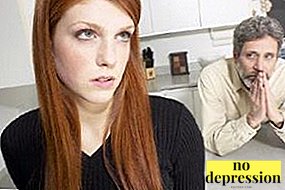 sluggish, continuous and paroxysmal form (separation is carried out according to the characteristics of the course of the disease);
sluggish, continuous and paroxysmal form (separation is carried out according to the characteristics of the course of the disease);- simple, paranoid, hebephrenic and catatonic form (depending on the general symptoms of the disease);
- initial, developed stage and defect (according to the degree of progression of the pathological condition).
At the initial stage schizophrenia develops in a latent form. Symptoms of the disease resemble the usual mood swings or mild depressive states.
Deployed stage accompanied by increased symptoms and more pronounced its severity. Signs of schizophrenia become regular, and the cause of their occurrence cannot be established.
The most dangerous stage is a defect. This form of schizophrenia provokes persistent personality changes and impaired thinking.
How to recognize the first signs?
The first symptoms of schizophrenia in women in most cases after reaching the age of twenty. In rare cases, earlier signs of the disease are possible.
The first symptoms of schizophrenia have a negative impact on the behavior of the woman and her psycho-emotional state. Visually, the symptoms of the disease do not appear.
Indicate the development of schizophrenia The following factors may:
 tendency to hallucinations (a woman hears voices, sees non-existent objects);
tendency to hallucinations (a woman hears voices, sees non-existent objects);- sudden and unwarranted attacks of aggression or irritability;
- decrease in emotional sensitivity (scant manifestation of joy, sadness, etc.);
- complaints of a hypochondriac nature (inventing diseases and identifying their symptoms);
- exaggerating the importance of his person (too high self-esteem);
- difficulty expressing one's thoughts (a woman chooses words for a long time);
- sudden denial of personal hygiene (appearance becomes untidy, the woman completely ceases to look after herself);
- immersion in the world of fantasy (the patient seems to live in a "different world");
- the appearance of obsessive fears (in their initial absence);
- sudden change of interests or their sudden absence;
- the emergence of delusions and obsessive thoughts;
- propensity to perform compulsions (specific rituals);
- psychopathic behavior (bright flashes of irritability).
About the first symptoms of schizophrenia in women in this video:
What are the symptoms?
Symptoms of schizophrenia in women may occur with varying degrees of intensity. Changes become sudden or gradual. The key role in this case is played by the initial state of mind of the patient.
Identifying a woman with even a few characteristic symptoms of schizophrenia, is the basis for conducting a comprehensive survey to identify mental disorder.
TO symptoms of schizophrenia women have the following conditions (see photo):
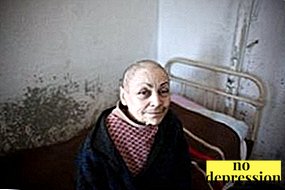 protracted depression (apathy and pessimism are becoming the distinctive features of women);
protracted depression (apathy and pessimism are becoming the distinctive features of women);- hypochondria (the search for fatal diseases not only at home, but also of children, relatives or friends);
- bouts of anger and aggression (conditions can occur when a woman is alone and there are no irritating factors);
- hallucinations (auditory, visual, tactile);
- insomnia of various etiologies or unexplained;
- mood swings (laughter replaces crying, sudden cry);
- sudden weakness (bouts of lethargy may become regular);
- personality mutation (perception of self is violated);
- obsessive fears (gradually turning into persistent mental disorders);
- crazy states (can be supplemented with phobias);
- depersonalization (lack of control over your own actions);
- suicidal thoughts (as well as a tendency to alcoholism or drug use).
Features at different ages
The intensity of the symptoms of schizophrenia may vary depending on the age category women. Some nuances make it difficult to diagnose.
For example, in old age, women are prone to suspicion, hypochondria, and fears associated with old age.
Similar symptoms may be associated with schizophrenia, therefore distinguish mental disorder from senile changes to relatives will be extremely difficult.
Symptoms of schizophrenia in women, depending on age group:
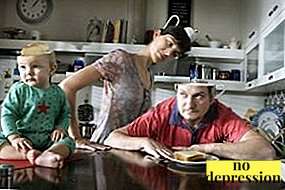 Have girls (A distinctive feature of the symptoms of schizophrenia in this age group of patients is obsession with their physical disabilities and the development of obsessive states, phobias and other mental disorders in their background).
Have girls (A distinctive feature of the symptoms of schizophrenia in this age group of patients is obsession with their physical disabilities and the development of obsessive states, phobias and other mental disorders in their background).- Among women middle-aged (for this age group of women, a characteristic symptom is the presence of delusional states associated with pathological jealousy, fear of persecution, the clinical picture is complemented by common signs of schizophrenia).
- In older women (in old age, social dysfunctions, hallucinations, pronounced dullness of reactions, inadequate behavior and impaired thinking, memory, including short-term amnesia) are characteristic manifestations of schizophrenia.
What methods include treatment?
Therapy for Schizophrenia in Women different duration. For several months, the main treatment is carried out, then the dosages of the drugs are reduced, corrective psychotherapy is carried out.
At the final stage of therapy it is necessary to consolidate the result and reduce the risk of recurrence of the disease.
The use of special medications is an integral part of the treatment of schizophrenia. Drugs are selected depending on the individual clinical picture of the patient's state of health.
Schizophrenia Therapy in women includes the following techniques:
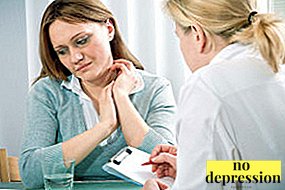 Neuroleptic treatment (drugs in this category eliminate aggression, delusions, create a good prevention of amplification of symptoms and the appearance of hallucinations in women).
Neuroleptic treatment (drugs in this category eliminate aggression, delusions, create a good prevention of amplification of symptoms and the appearance of hallucinations in women).- Drug therapy timostabilizers, nootropics and antidepressants (Triftazin, Aminazin, Olanzapine, Haloperidol, etc.).
- Psychotherapy (The method includes individual lessons with a specialist, work with the patient’s family, correction of a woman’s behavioral response and normalization of her self-esteem).
- Intravascular blood irradiation, electroconvulsive treatment and insulin therapy (such techniques are assigned individually, and are auxiliary, certain indications are necessary for their use).
- Psychological and social adaptation (these methods are a mandatory step in the treatment of schizophrenia and an integral part of therapy; in case of complications, special procedures are carried out in the hospital).
- Treatment in a specialized hospital (the need for hospitalization of a woman arises in case of critical damage to the psyche and the maximum manifestation of schizophrenia symptoms)
Therapy for schizophrenia in women involves three main stages. Active treatment and elimination of existing symptoms takes an average of two or three months. At this stage, medications and procedures are used to stabilize the psycho-emotional state.
Stabilizing therapy carried out in the next three months. This stage is characterized by the control of the patient's psyche and the regulation of the dosages of the drugs used. The duration of maintenance treatment can be as long as six months or longer.
Prognosis to recovery

Predictions for Schizophrenia depends not only on the timeliness of therapy, but also on the stage of disease progression and the degree of mental impairment in women
Irreversible changes occur at the stage of psycho-emotional state defect.
In the early stages of development, schizophrenia responds well to correction, but therapeutic measures for the patient should be applied regularly.
Prediction options in women with schizophrenia:
- achieving persistent remissions (can last for years and not bother the patient);
- rapid deterioration and progression of schizophrenia (with late diagnosis, improper treatment or ignoring the symptoms of mental disorder);
- prolonged inpatient treatment (hallucinations, delusional states and other symptoms of schizophrenia become persistent and irreversible).
Schizophrenia is a deadly disease. The lethal outcome can be provoked not by the changes occurring in the woman’s body, but by their consequences.
Depression and the presence of phobias can in a short amount of time. cause suicide. If the therapy is carried out in a timely manner and fully, then the quality of a woman’s life can be greatly improved.
Acute nonsense in women with schizophrenia:

 sluggish, continuous and paroxysmal form (separation is carried out according to the characteristics of the course of the disease);
sluggish, continuous and paroxysmal form (separation is carried out according to the characteristics of the course of the disease); tendency to hallucinations (a woman hears voices, sees non-existent objects);
tendency to hallucinations (a woman hears voices, sees non-existent objects); protracted depression (apathy and pessimism are becoming the distinctive features of women);
protracted depression (apathy and pessimism are becoming the distinctive features of women); Have girls (A distinctive feature of the symptoms of schizophrenia in this age group of patients is obsession with their physical disabilities and the development of obsessive states, phobias and other mental disorders in their background).
Have girls (A distinctive feature of the symptoms of schizophrenia in this age group of patients is obsession with their physical disabilities and the development of obsessive states, phobias and other mental disorders in their background). Neuroleptic treatment (drugs in this category eliminate aggression, delusions, create a good prevention of amplification of symptoms and the appearance of hallucinations in women).
Neuroleptic treatment (drugs in this category eliminate aggression, delusions, create a good prevention of amplification of symptoms and the appearance of hallucinations in women).

